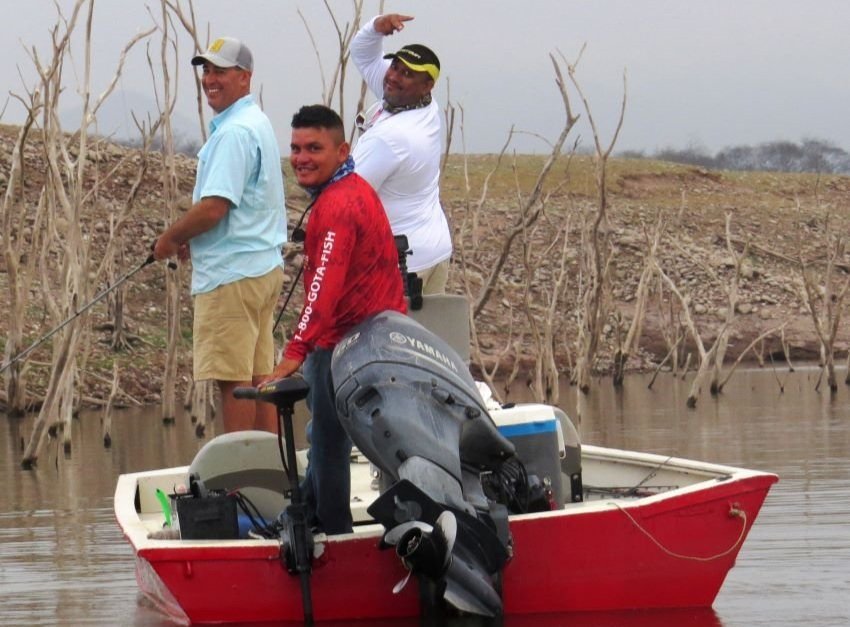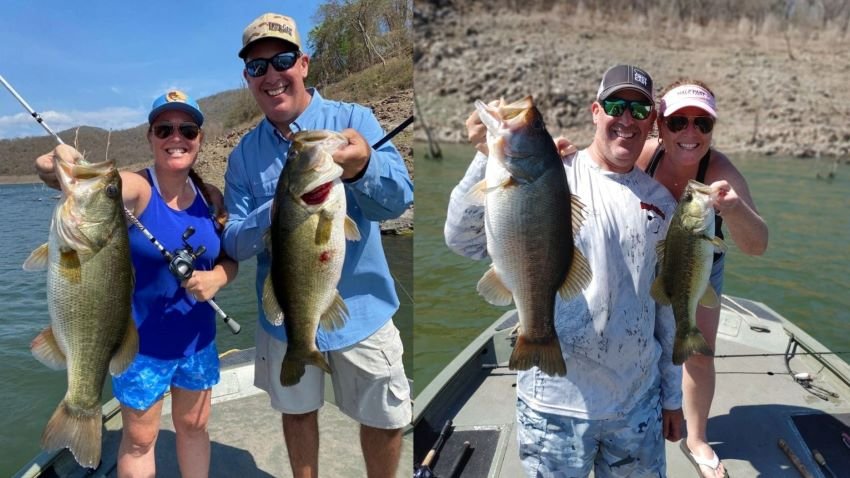Working With Your Partner at El Salto and Picachos
After over 20 trips to Lake El Salto and Lake Picachos, 90 percent of them together, Hanna and I have a solid routine once we’re in the boat. We understand each other’s tendencies and movements and while truth be told we’d rather catch the big ones ourselves, we still celebrate when the other succeeds. There are the occasional sideways glances and choice words when we think the other one has made a selfish cast, but they’re few and far between – we’ve recognized that in the long run working together produces far better results for everyone than competing with the other person in the boat.
I typically don’t realize how seamlessly we work together until I fish with someone else. One of the joys of taking a big group down to Mexico is that I get to fish with both longtime friends and first-timers, but it’s always something of an awkward dance at first, figuring out how they act and move in the boat. You want to be on your best behavior, but you also want to make the most of your time on the water.
One lesson that I learned in tournament fishing a long time ago is that the more time you spend worrying about the other person in the boat, the less time you have to concentrate on the task at hand. If you’re constantly positioning the boat so that they cannot cast in front of you or get access to the best targets, you’ve already lost. “Playing defense” will kill you more than any cold front or tough bite. Here are some ways to ensure that you’re always on the same team:
Know Where Your Partner is At All Times
I consider it a huge advantage that I am left-handed and Hanna is right-handed. When we get in the boat at Anglers Inn, all of my gear is on the port side, and that’s where I sit, and she claims the starboard side.
When the boat comes to a halt, we bound up to the front deck on our respective sides, our angles predetermined. If we’re casting straight ahead, there’s no conflict. If the boat is going left to right, she’s in the front and I’m to the left of her, slightly toward the back of the boat. If we’re going right to left, it’s the opposite. Sometimes that means that one person will have a huge advantage in terms of presentations. That’s just a fact of life, and if you want to ensure that you’re always in position to catch fish you won’t completely screw your partner over when you are in the prime position. Also, it’s incumbent on the person who has the second shot to tailor his or her lure choices to the situation. If the person in front is fishing a topwater or spinnerbait with 45 degree casts to the bank, perhaps make shorter casts or pitches with a Senko or a jig. You’ll be surprised at how often you catch bass, even giants, that your partner misses.
On rare occasions Hanna and I will switch positions based on lure choices. If I’m fishing something aggressive and she’s fishing something slower we’ll reverse spots – otherwise you end up rushing and/or slowing down the other person.
One other important aspect of this is knowing where your partner is at all times. I haven’t experienced it yet, but you don’t want to get whacked in the noggin by a giant crankbait like a 10XD or strangled by a Carolina Rig. When one of us heads toward the tackle bag to grab another bait (or a Pacifico) or otherwise moves out of the expected position, we’ll say “Behind you” or some other short phrase that indicates the person should be careful when casting or setting the hook.
Choosing Baits, Choosing Angles
There are times at El Salto when it doesn’t really matter what you throw – the fish are clearly on the chew. There are also times when you get dialed in on a particular lure, color, pattern or retrieve and there’s no reason to throw much of anything else, except to keep the fish a little bit honest.
Most of the time, however, by having a second person in the boat you can dial in the bite much more quickly. I know that some people prefer to fish alone on vacation (even sometimes paying a supplemental fee to do so) but if you work wisely with a partner, the results can be more than the sum of their parts.
Some of that comes down to lure choices. Obviously, as explained above, if one of you is covering lots of water with a spinnerbait or crankbait, the other can slow down with a Carolina Rig, jig or Senko and milk the high percentage spots. Once you’ve decided that the fish prefer, for example, a crankbait, you can throw two different ones – such as a Strike King 6XD and a Fat Free Shad – to see if there’s a preference there. If you establish that there is, throw two substantially different colors to see if there’s a further preference. Make sure that you’re making an honest assessment. One of you may get more bites on a different colored lure, but it may be because of your line choice or retrieve speed rather than just the color. It’s easy to get focused on false positives.
Experiment with both different sizes and different colors. Does a 6-inch Senko work better than a 7-incher? Within a particular size, does color make a difference? Sometimes it matters, sometimes it’s just a function of who hits the prime target area first. We’ve seen greater differences when it comes to topwaters. Some days the fish want the movement of a walking bait or a Whopper Plopper, while on other days the target-specific pauses of a Rio Rico are the ticket. It’s easy to get locked in on what you’d rather catch them on, but if you want to catch more fish it pays to stay focused on your quarry’s preferences. That can more easily ascertained if you work with a partner – and it benefits from a full and frank discussion of the things that seem to be working best. That could be pausing your jerkbait for longer periods of time, or it could be adding a heavier weight to your worm. It changes constantly and more honest data produces better results.
I subscribe to an “80/20 rule” when it comes to new lure testing in Mexico. In other words, don’t spend more than 20% of your time fishing new or unproven lures. A corollary to this is that you and your partner should rarely (or preferably NEVER) both fish unproven lures at the same time. If you neglect that rule and you don’t catch fish, you’ll never know if the area was barren or you just had the wrong presentation.
Finally, in terms of positioning, when your partner has that fish of a lifetime on the line, be sure to stay out of his or her way. More than any place else I’ve ever fished for bass, the El Salto schools seem to fire one another up, so you’ll want to get in a cast while they’re amped, but wait until your partner’s bass is in the net. If you’re convinced that time is of the essence, let the guide snap their picture while you try to get in on the action.
Packing and Planning Tips
If you’ll be fishing with the same partner most or all of the time on your trip to El Salto or Picachos, space in your luggage and in the boat may be of the essence. Most of the time you may be limited to 50 pounds in your checked luggage, so it takes a bit of discretion to make sure that you’ll have ample supplies of everything that you need.
Similarly, while the boats have sizeable decks and plenty of room for tackle bags, storage binders and utility boxes, the more crap you cram the harder it will be to move around as well as more difficult to find things when you need them. It pays to consolidate as much as possible. For example, you likely don’t need TWO scales. If you trust one, so be it (bring extra batteries) and note that some of the guides have one of their own. Similarly, you can save space and money by buying things you need in bulk, such as EWG worm hooks, bulk bags of Senkos, and 100 count bags of 10-inch Berkley Power Worms (if you can find them). Pack one combined bag of soft plastics, and if you elect to fish with a different partner for one or more sessions, have a “go bag” with enough to get you through a day of hot fishing. That’s how Hanna and I handle things since we primarily fish together but occasionally get to spend time in the boat with other friends. If you really trust your partner, have one tackle bag for soft plastics and another for hard baits, jigs and wire baits.
If you’re bringing a GoPro or camera gear, you only need one set of that as well. You can share footage and pictures later.
I promise you that you will have a better time, and be more productive over the long haul if you follow these tips. There’s a thrill in catching a big bass, and a different satisfaction in seeing your fishing partner catch one, but the best feeling of all is to return to the lodge for lunch or dinner both happy that you maximized the bite that was available.
Sorry, I’m not giving up my fishing partner for more than a session or two, but if you’d like to go to El Salto or Picachos, including on a hosted trip (where you might get to fish with us if you’d like), email Hanna and she can get the ball rolling on your trip of a lifetime.








